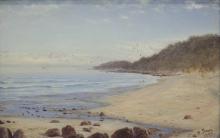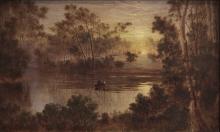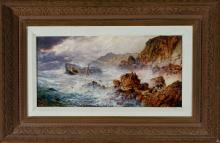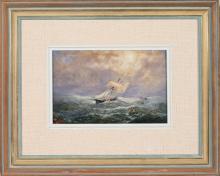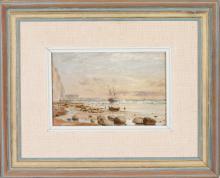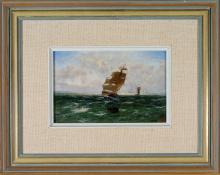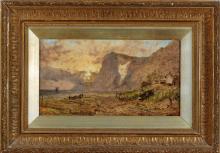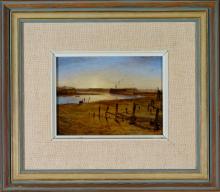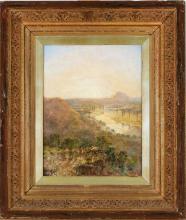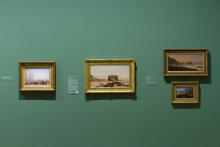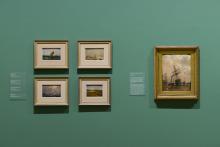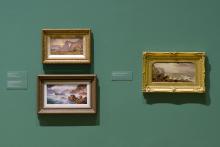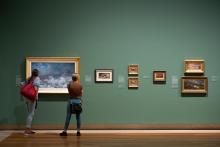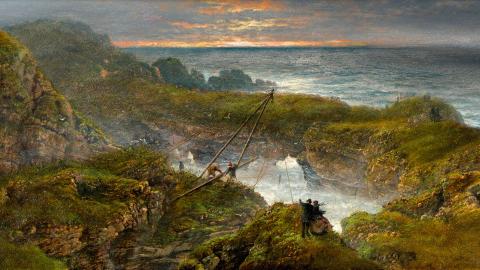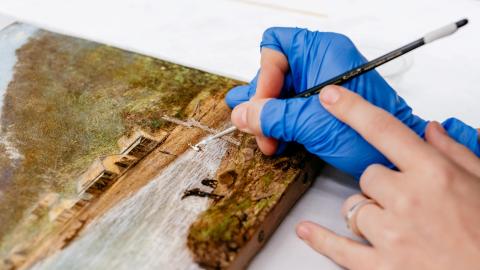WORKS ON LOAN: ‘A Feeling for Light’
‘Isaac Walter Jenner: A Feeling for Light’ includes works on loan from Ipswich Art Gallery, Museum of Brisbane, National Gallery of Australia, Philip Bacon Galleries, University of Queensland Art Museum, and private collections around Australia. Discover more about these works on loan, or explore the Collection works featured in the exhibition.
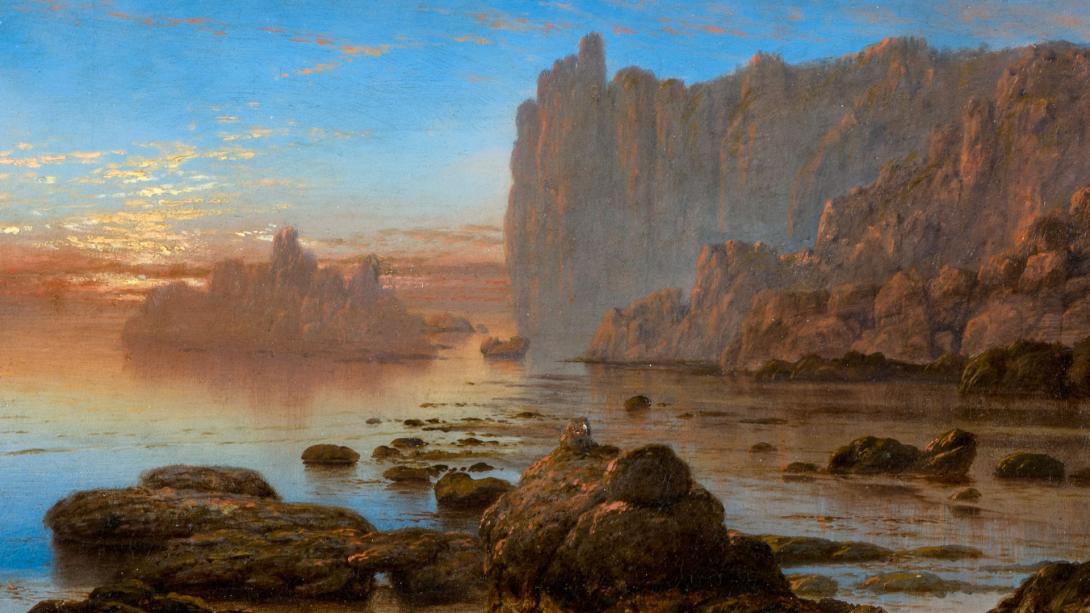
Feature image: Isaac Walter Jenner / England/Australia 1836–1902 / Sunset from a rocky coast (detail) 1890 / Gift of a private donor through the Ipswich Art Gallery Foundation, 2022 / Collection: Ipswich Art Gallery / Photograph: M Richards
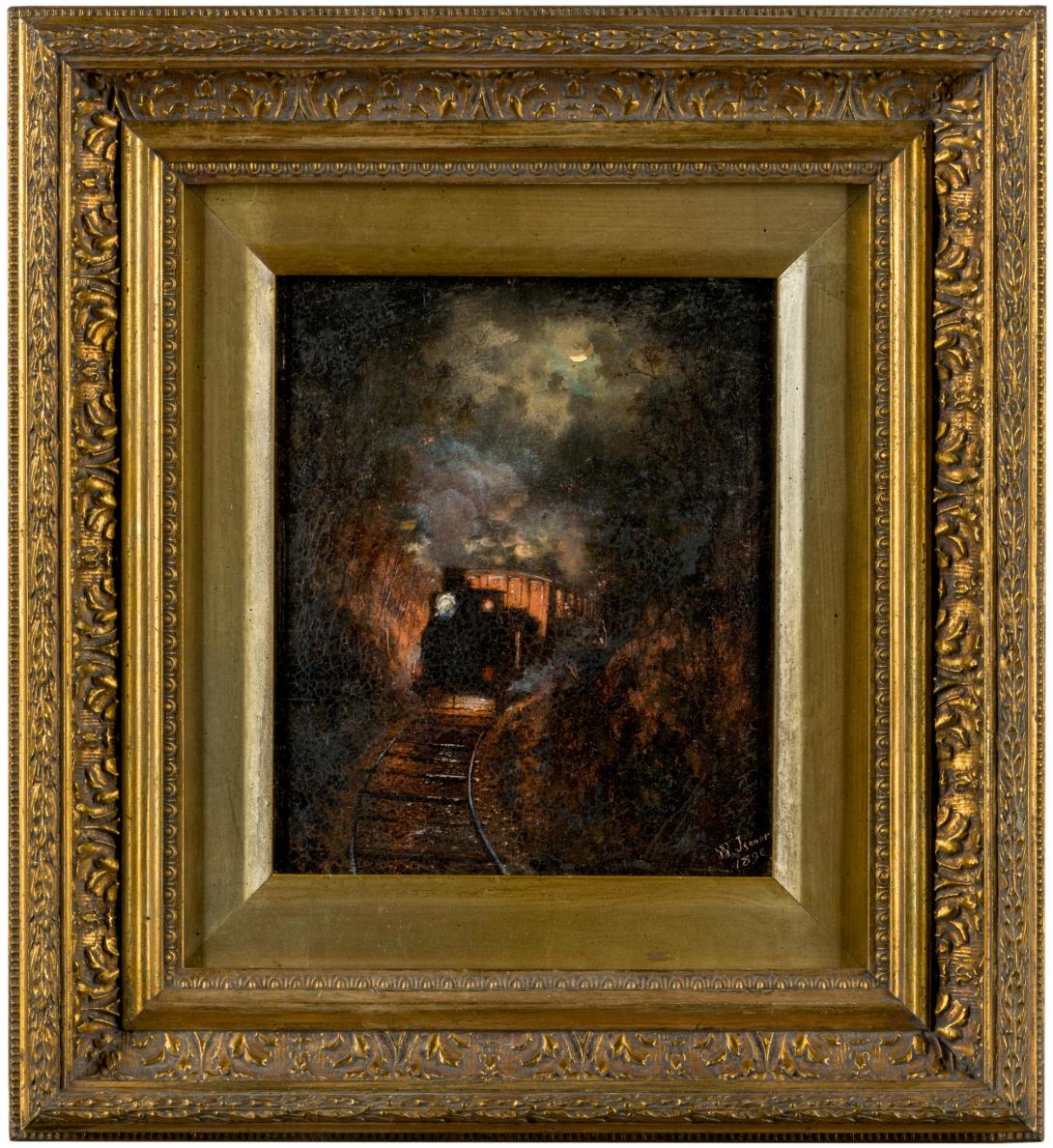
Steam engine coming round the bend into Goodwood Station 1896 / Collection: Ipswich Art Gallery / Photograph: Mick Richards
Steam engine coming round the bend into Goodwood Station 1896
Oil on academy board
18 x 15.2cm
Acquired with funds donated by Amex Corporation through the Ipswich Art Gallery Foundation, 2006
Collection: Ipswich Art Gallery
A passenger train arrives at the Goodwood railway station, south of Bundaberg. The engine cuts through the still country night with a noisy rush of steam, puffing smoke, its lights illuminating the carriages and surrounding countryside. Jenner’s atmospheric effects and gestures towards the romantic and sublime gave rise to his local reputation as a follower of JMW Turner. Like Turner, Jenner focuses on the interplay between light and the surroundings, with the red glow from the engine’s open firebox brightly illuminating the passenger carriages behind. It gives a soft, atmospheric effect as it blends with the smoke from the smokestack, which in turn mingle with the clouds and moonlight above. Jenner may have observed this scene from the Goodwood station platform, perhaps while visiting his daughter Clara, whose husband, Richard Shale, was the station master there.
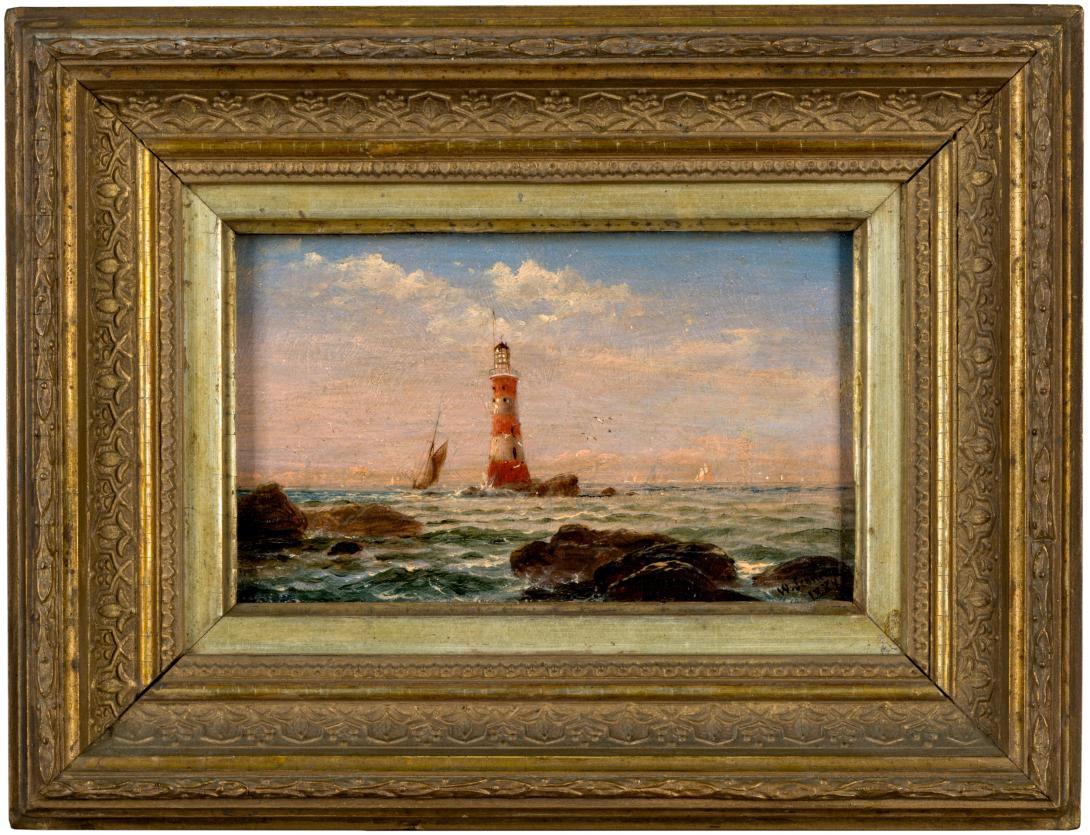
The Late Eddystone Lighthouse, Smeaton's off Plymouth S. Devon 1885 / Collection: Ipswich Art Gallery / Photograph: Mick Richards
The Late Eddystone Lighthouse, Smeaton's off Plymouth S. Devon 1885
Oil on board
9.5 x 15.4cm
Gift of a private donor through the Australian Government's Cultural Gifts Program, 2013
Collection: Ipswich Art Gallery
The Eddystone lighthouse, located 14 kilometres south of Plymouth in Devon, was designed by civil engineer John Smeaton and completed in 1759, taking the place of two earlier lighthouses dated1699 and 1708. The lighthouse warmed ships of the perilous Eddystone rocks visible in the foreground of this painting.
Jenner would have been well-acquainted with the lighthouse during his time in the British Navy and owned a small booklet on the history of the three Eddystone lighthouses. In this painting, Jenner captures the scene of the third lighthouse built on the site, which was constructed using a revolutionary all-masonry design.
A small sailing ship is pictured on the left-hand side, alert to the dangers ahead. This work was composed in 1885, when Jenner had recently settled in Brisbane; the ‘late’ Eddystone lighthouse was replaced by a fourth lighthouse in 1882.
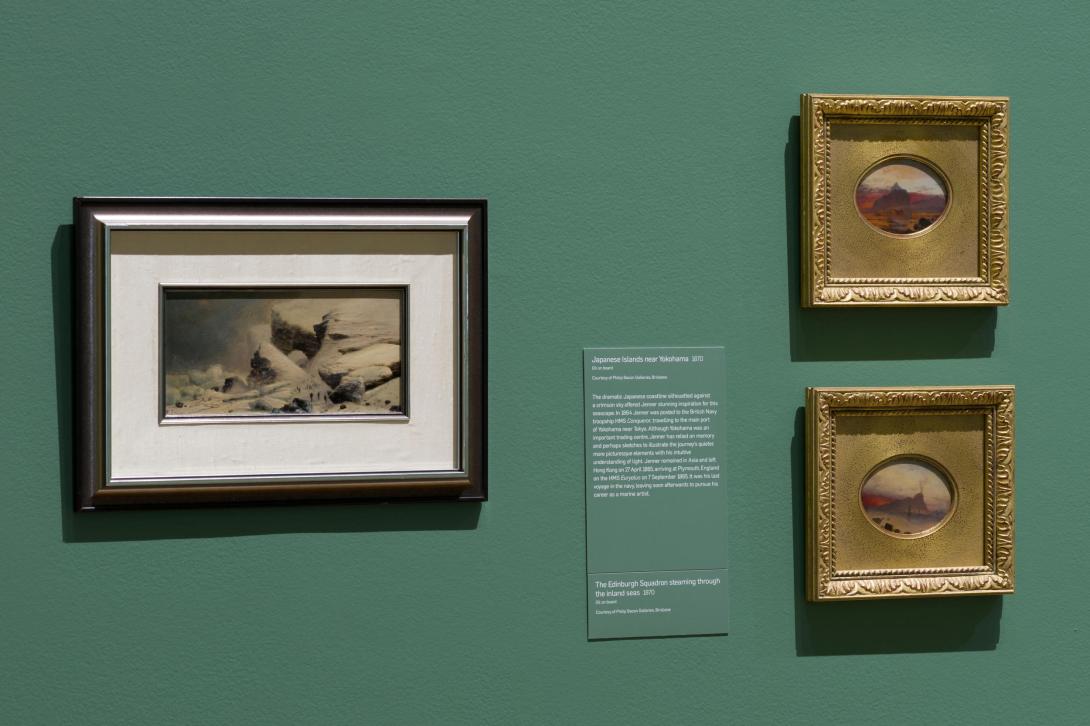
An installation view of artworks featured in ‘A Feeling for Light’ (l–r): Heligoland 1896, Japanese Islands near Yokohama 1870 and The Edinburgh Squadron steaming through the inland seas 1870 (Collection: Philip Bacon Galleries, Brisbane), QAG, September 2023 / Photograph: Chloë Callistemon, QAGOMA
Philip Bacon Galleries, Brisbane
Gathering flotsam and jetsam 1881
Oil on board
19 x 38cm
Collection: Philip Bacon Galleries, Brisbane
Heligoland 1896
Oil on academy board
15 x 30cm
Collection: Philip Bacon Galleries, Brisbane
Heligoland is a small archipelago in the German Bay of the North Sea, 65 kilometres from the German mainland. During the early 1850s, Jenner had sailed north to the Barents Sea, travelling to Lapland, Novaya Zemlya and Spitsbergen within the Arctic Circle. He also travelled to the Baltic Sea while serving the British Navy from 1855–65. Jenner may have visited Heligoland during these voyages, as it was under British rule from 1807–90 and had a large deep-water harbour. Dwarfed by a hostile frozen landscape, small human figures, perhaps fishermen or herders, are seen in the foreground.
Japanese Islands near Yokohama 1870
Oil on board
14 x 13.5cm
Collection: Philip Bacon Galleries, Brisbane
The dramatic Japanese coastline, silhouetted against a crimson sky, offered Jenner stunning inspiration for this seascape. In 1864, he was posted to the British Navy troopship HMS Conqueror, travelling to the main port of Yokohama, near Tokyo. Although Yokohama was a bustling centre of trade, Jenner has illustrated — from memory and perhaps sketches — the journey’s quieter, more picturesque elements, with his intuitive understanding of light. The artist remained in Asia, leaving Hong Kong on 27 April 1865 and arriving at Plymouth on the HMS Euryalus some four months later on 7 September. It was Jenner’s last voyage in the Navy, leaving soon afterwards to pursue his career as a marine artist.
The Edinburgh Squadron steaming through the Inland Seas 1870
Oil on board
10 x 13.5cm
Collection: Philip Bacon Galleries, Brisbane
Ship aground Cornwall Coast n.d.
Oil on academy board
29.2 x 40.7cm
Collection: Philip Bacon Galleries, Brisbane
Weymouth c.1881
Oil on academy board
19.4 x 39.7cm
Collection: Philip Bacon Galleries, Brisbane
In the Georgian period, when medical science of the day declared sea-bathing to be good for health, Weymouth began its rise as a seaside resort. King George III’s decision to take the waters in Weymouth in 1789 led the town to become the most celebrated and visited watering-place in the land. During the Victorian period, the town continued as a popular resort and the harbour flourished with the growth of seaborne trade with the Channel Islands. The arrival of the railway in 1857 enabled Weymouth to continue to grow.
Private collections
Arched Rock c.1876
Oil on canvas
41 x 68.7cm
Collection: Ian Callinan AC, Brisbane
Arched Rock was a famous sedimentary landmark in Freshwater Bay, on the western side of the Isle of Wight. Popular with holidaymakers, the island is south of Portsmouth, where Jenner was based while serving in the British Navy (1855–65). Now working as a landscape and marine artist in Brighton, Jenner painted a series of coastal views of eroded rocks and cliff strata studies, exemplifying an increasing interest in new geological theories at that time.
The new science of geology challenged creation myths of the past and soon influenced the style and content of late nineteenth-century landscape painting. The composition includes tiny boats and human activity in the background, with Jenner seeking to convey something of the sublime by contrasting the ephemerality of humankind against the grandeur of nature. The painting shows detailed sedimentary layers of chalk, a brittle form of limestone subject to erosion. Arched Rock finally collapsed on 25 October 1992.
Learn more about geology’s radical influence on landscape painting.
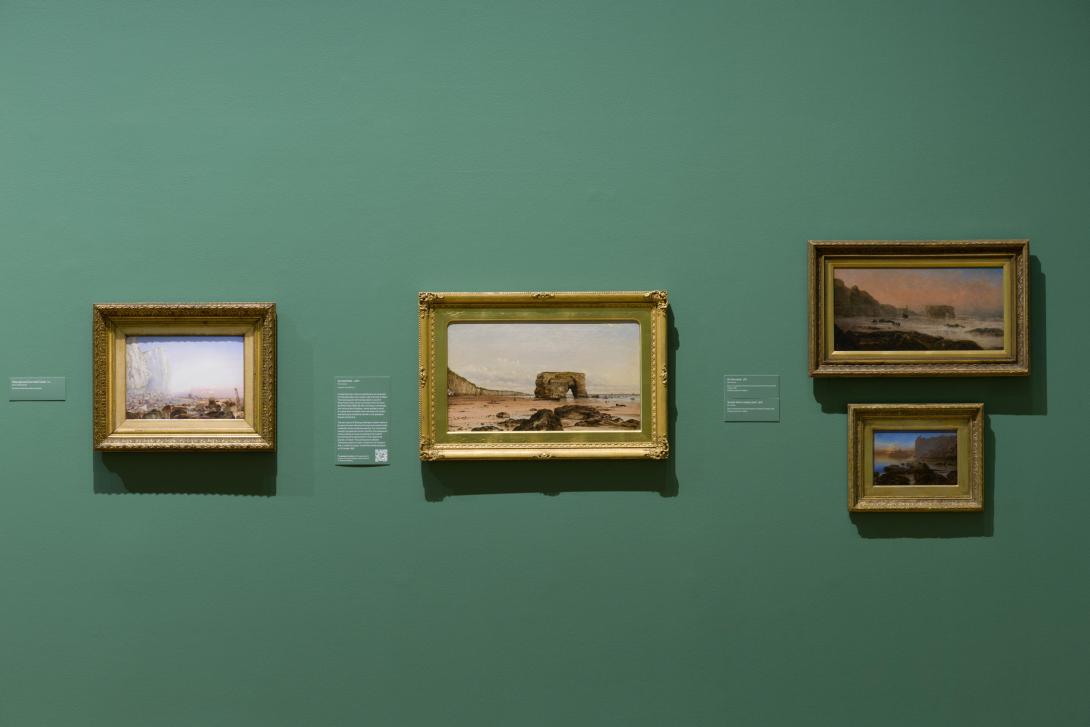
An installation view of artworks featured in ‘A Feeling for Light’ (l–r): Ship aground Cornwall Coast n.d. (Collection: Philip Bacon Galleries, Brisbane). Arched Rock c.1876 (Collection: Ian Callinan AC), On the coast 1897 and Sunset from a rocky coast 1890 (Collection: Ipswich Art Gallery), Gallery 14, QAG, September 2023 / Photograph: Chloë Callistemon, QAGOMA
(Family group sailing model boat in bush scene) c.1889
Watercolour on paper
111.5 x 41.6cm
Private collection, Canberra
This portrait of a young family in bushland may give a rare glimpse into Jenner’s family. Arriving in Brisbane in 1883 with seven children, Jenner was blessed with grandchildren soon afterwards. Here, some boys — possibly his grandsons — are playing with a toy boat as their aproned mother with babe in arms looks on. The model boat is seen as a nod to Jenner’s nautical background. The towering, elegant ironbark overhead contrasts sharply with the many tree stumps and trees felled for the growing city. In the middle distance is a homestead with two cows resting nearby. The foreground shows Jenner’s skill at textural technique, displayed in the rocks surrounding the pond and the fallen timber in front of the toy boat. Jenner composed many works featuring local timbers, as his Taringa home on Montrose Street was close to the foothills of Mt Coot-tha. It would have been an enjoyable walk with his family to sketch and play in the surrounding bushland.
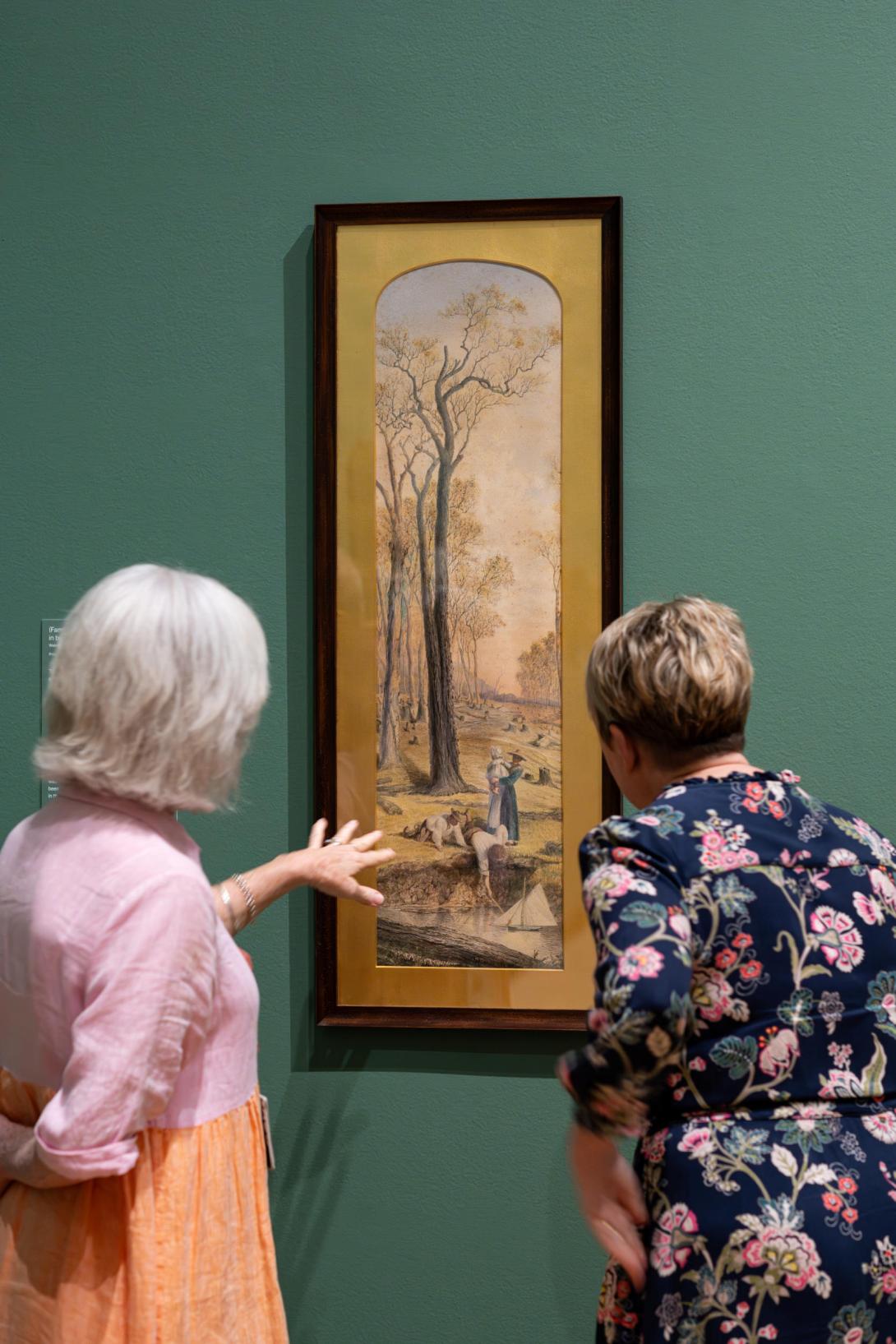
(Family group sailing model boat in bush scene) 1889 (installation view) / Private collection, Canberra / Gallery 14, QAG, September 2023 / Photograph: Chloë Callistemon, QAGOMA
Ipswich Road to Mount-Cootha 1890
Oil on canvas
30.5 x 20.1cm; 46.8 x 36.6cm (framed)
Private collection, Brisbane
Royal Albert and Donegal, Bay of Biscay, night of Nov. 7th 1860 1860
Pencil on paper
45 x 34.5cm
Collection: Ian Callinan AC, Brisbane
During Jenner’s naval career, he was assigned to the HMS Royal Albert (1856–61), the flagship of the British Navy Channel Squadron. Jenner appears to have documented a near-collision between the Royal Albert and Donegal — a significant and frightening experience in heavy weather. The Royal Albert and Donegal left Plymouth Sound on 6 November, each bound for Lisbon, returning to Plymouth on 20 December 1860.
The Donegal left the harbour under sail while the Royal Albert had left under steam, soon ‘putting out the fires’ to the boilers as there was a strong wind blowing from the east. By the following day, both ships had entered the Bay of Biscay, just north of Spain — a notorious region known for bad weather, rough seas and countless shipwrecks and perhaps where the near-collision occurred. The inscription on the left states, ‘Donegal on a wind’, and on the right, ‘R. Albert before the wind’.
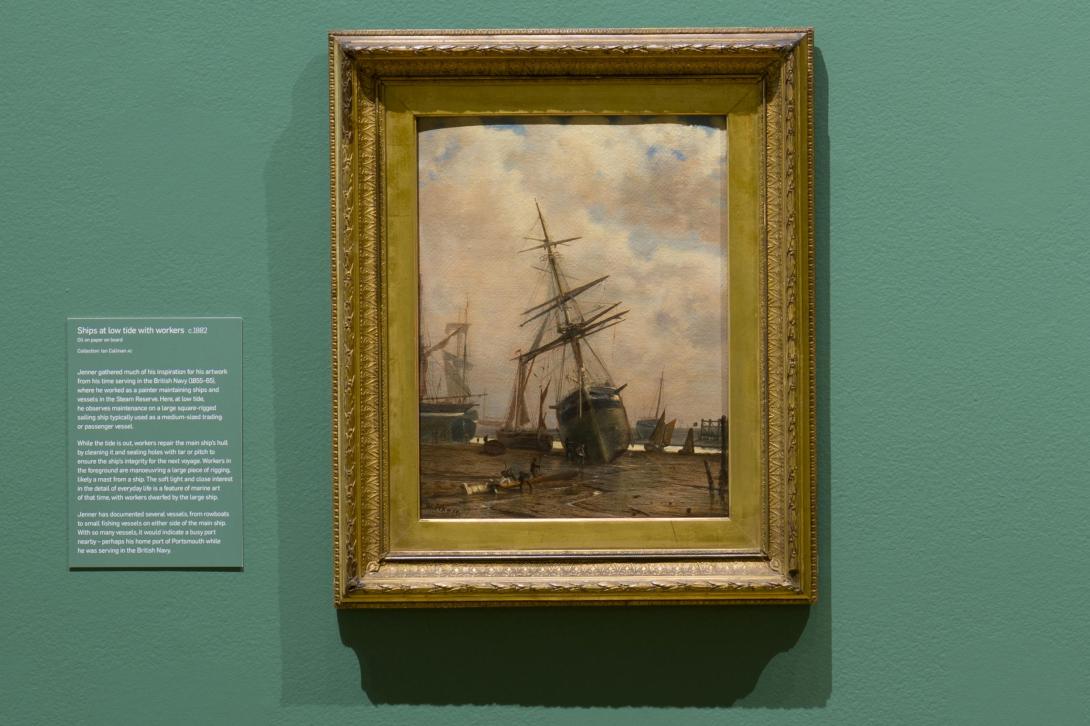
Ships at low tide with workers c.1882 (installation view) / Collection: Ian Callinan AC, Brisbane / Gallery 14, QAG, September 2023 / Photograph: Chloë Callistemon, QAGOMA
Ships at low tide with workers c.1882
Oil on paper on board
45 x 34.5cm
Collection: Ian Callinan AC, Brisbane
Jenner gathered much of his artistic inspiration from his time serving in the British Navy (1855–65), where he worked as a painter maintaining ships and vessels in the Steam Reserve. Here, at low tide, he observes maintenance on a large square-rigged sailing ship typically used as a medium-sized trading or passenger vessel.
While the tide is out, workers repair the main ship’s hull by cleaning it and sealing holes with tar or pitch to ensure the ship’s integrity for the next voyage. Workers in the foreground manoeuvre a large piece of rigging, likely a mast from a ship. The painting’s soft light and close detail of everyday life are characteristic of marine art of that time, with workers dwarfed by the large ship.
Jenner has documented several vessels, from rowboats to small fishing vessels, on either side of the main ship. Such a number of vessels indicates a busy port nearby — perhaps Portsmouth, his home base while he served in the British Navy.
Explore ‘A Feeling For Light’

Digital Story Introduction
ISAAC WALTER JENNERQAGOMA COLLECTION: ‘A Feeling for Light’
Read LIST OF WORKSDigital story context and navigation
ISAAC WALTER JENNERExplore the story

Digital Story Introduction
ISAAC WALTER JENNERQAGOMA COLLECTION: ‘A Feeling for Light’
Read LIST OF WORKS
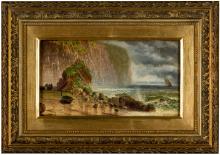


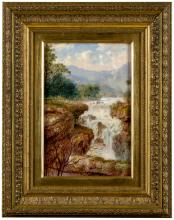
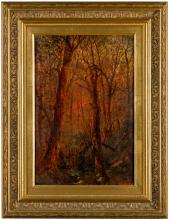
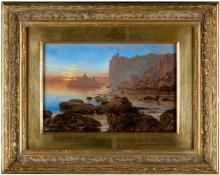
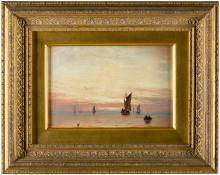
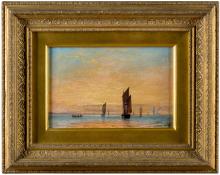
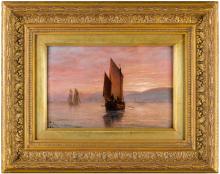
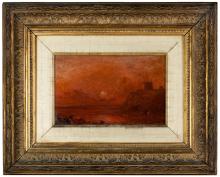
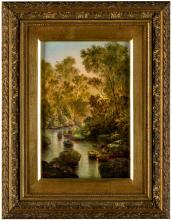
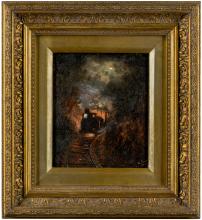
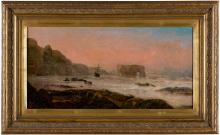
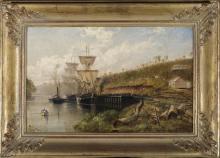
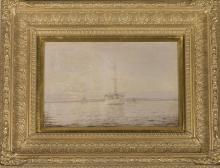
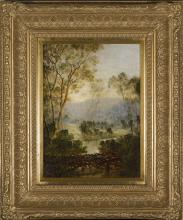
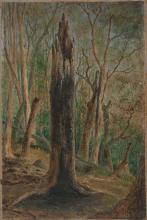
![<em>not titled [Sand dunes and clouds]</em> 1890s / Watercolour on paper / 27.2 x 35cm / Gift of The Hon. Ian Callinan AC QC 2011 / Collection: National Gallery of Australia, Canberra A watercolour painting of a sand dune on cream-coloured paper.](/sites/default/files/styles/medium/public/2023-08/212251_pm-Super%20Hi-Res%20Unclipped%20%28TIFF%204200px%29.jpg?itok=epRshevh)
